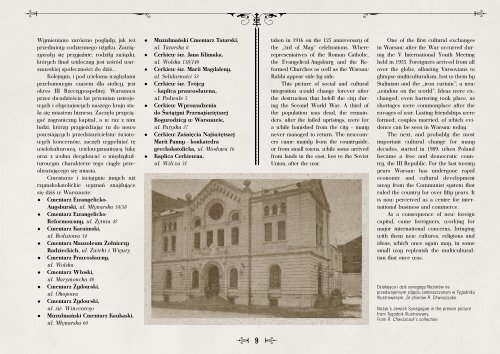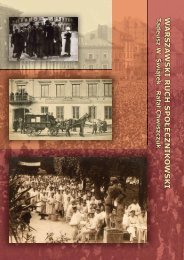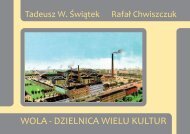Create successful ePaper yourself
Turn your PDF publications into a flip-book with our unique Google optimized e-Paper software.
Wymieniano zarówno poglądy, jak też<br />
przedmioty codziennego użytku. Zawiązywały<br />
się przyjaźnie, rodziły związki,<br />
których fi nał widoczny jest wśród warszawskiej<br />
społeczności do dziś...<br />
Kolejnym, i pod wieloma względami<br />
przełomowym czasem dla stolicy, jest<br />
okres III Rzeczypospolitej. <strong>Warszawa</strong><br />
przez dwadzieścia lat przemian ustrojowych<br />
i obyczajowych naszego kraju stała<br />
się miastem biznesu. Zaczęła przyciągać<br />
zagraniczny kapitał, a w raz z nim<br />
ludzi, którzy przyjeżdżając tu do nowo<br />
powstających przedstawicielstw światowych<br />
koncernów, zaczęli wypełniać tę<br />
wielo<strong>kultur</strong>ową, wielowyznaniową lukę<br />
oraz z wolna decydować o między<strong>kultur</strong>owym<br />
charakterze tego ciągle przeobrażającego<br />
się miasta.<br />
Cmentarze i świątynie innych niż<br />
rzymskokatolickie wyznań znajdujące<br />
się dziś w Warszawie:<br />
• Cmentarz Ewangelicko-<br />
Augsburski, ul. Młynarska 54/58<br />
• Cmentarz Ewangelicko-<br />
Reformowany, ul. Żytnia 42<br />
• Cmentarz Karaimski,<br />
ul. Redutowa 34<br />
• Cmentarz Mauzoleum Żołnierzy<br />
Radzieckich, ul. Żwirki i Wigury<br />
• Cmentarz Prawosławny,<br />
ul. Wolska<br />
• Cmentarz Włoski,<br />
ul. Marymoncka 40<br />
• Cmentarz Żydowski,<br />
ul. Okopowa<br />
• Cmentarz Żydowski,<br />
ul. św. Wincentego<br />
• Muzułmański Cmentarz Kaukaski,<br />
ul. Młynarska 60<br />
• Muzułmański Cmentarz Tatarski,<br />
ul. Tatarska 8<br />
• Cerkiew św. Jana Klimaka,<br />
ul. Wolska 138/140<br />
• Cerkiew św. Marii Magdaleny,<br />
al. Solidarności 52<br />
• Cerkiew św. Trójcy<br />
– kaplica prawosławna,<br />
ul. Podwale 5<br />
• Cerkiew Wprowadzenia<br />
do Świątyni Przenajświętszej<br />
Bogurodzicy w Warszawie,<br />
ul. Paryska 27<br />
• Cerkiew Zaśnięcia Najświętszej<br />
Marii Panny – konkatedra<br />
greckokatolicka, ul. Miodowa 16<br />
• Kaplica Cerkiewna,<br />
ul. Wilcza 31<br />
9<br />
taken in 1916 on the 125 anniversary of<br />
the „3rd of May” celebrations. Where<br />
representatives of the Roman Catholic,<br />
the Evangelical-Augsburg and the Reformed<br />
Churches as well as the Warsaw<br />
Rabbi appear side by side.<br />
This picture of social and cultural<br />
integration would change forever after<br />
the destruction that befell the city during<br />
the Second World War. A third of<br />
the population was dead, the remainders,<br />
after the failed uprisings, were for<br />
a while banished from the city – many<br />
never managed to return. The newcomers<br />
came mainly from the countryside,<br />
or from small towns, while some arrived<br />
from lands in the east, lost to the Soviet<br />
Union, after the war.<br />
One of the fi rst cultural exchanges<br />
in Warsaw after the War occurred during<br />
the V International Youth Meeting<br />
held in 1955. Foreigners arrived from all<br />
over the globe, allowing Varsovians to<br />
glimpse multiculturalism, lost to them by<br />
Stalinism and the „iron curtain”; a new<br />
„window on the world”. Ideas were exchanged;<br />
even bartering took place, as<br />
shortages were commonplace after the<br />
ravages of war. Lasting friendships were<br />
formed; couples married, of which evidence<br />
can be seen in Warsaw today.<br />
The next, and probably the most<br />
important cultural change for many<br />
decades, started in 1989, when Poland<br />
became a free and democratic country,<br />
the III Republic. For the last twenty<br />
years Warsaw has undergone rapid<br />
economic and cultural development<br />
away from the Communist system that<br />
ruled the country for over fi fty years. It<br />
is now perceived as a centre for international<br />
business and commerce.<br />
As a consequence of new foreign<br />
capital, came foreigners, working for<br />
major international concerns, bringing<br />
with them new cultures, religions and<br />
ideas, which once again may, in some<br />
small way replenish the multiculturalism<br />
that once was.<br />
Działająca i dziś synagoga Nożyków na<br />
przedwojennym zdjęciu zamieszczonym w Tygodniku<br />
Illustrowanym. Ze zbiorów R. Chwiszczuka.<br />
Nożyk’s Jewish Synagogue in the prewar picture<br />
from Tygodnik Illustrowany.<br />
From R. Chwiszczuk’s collection.




